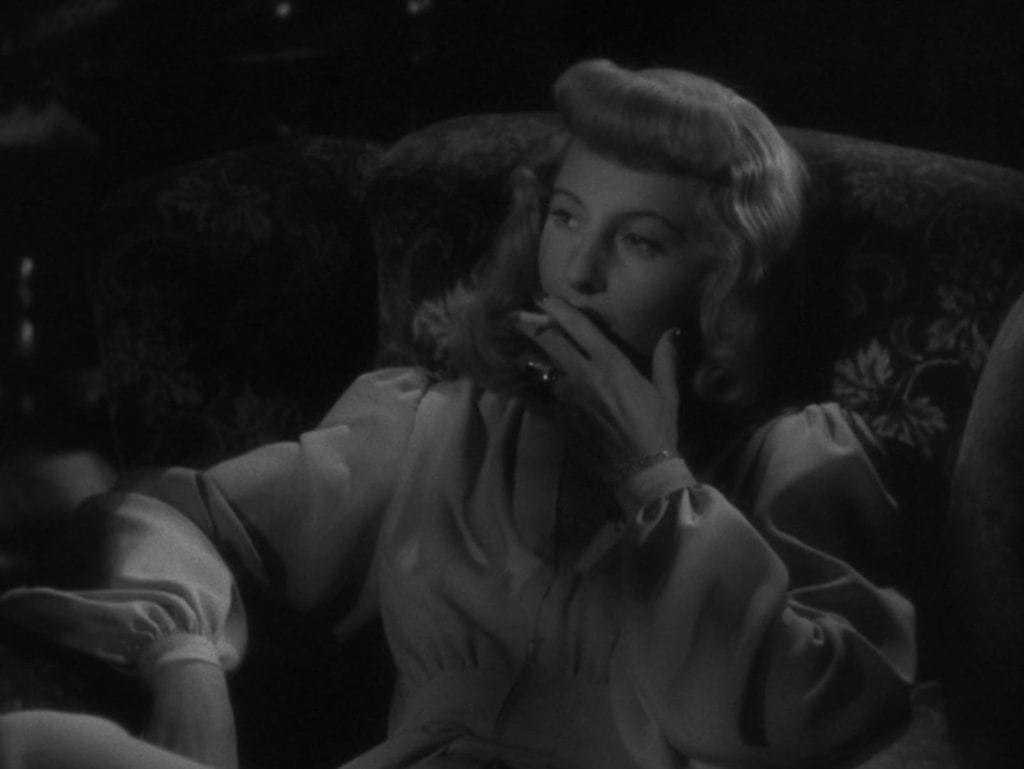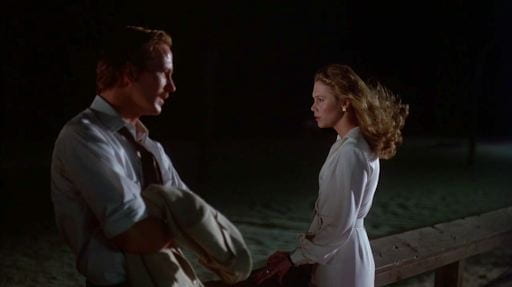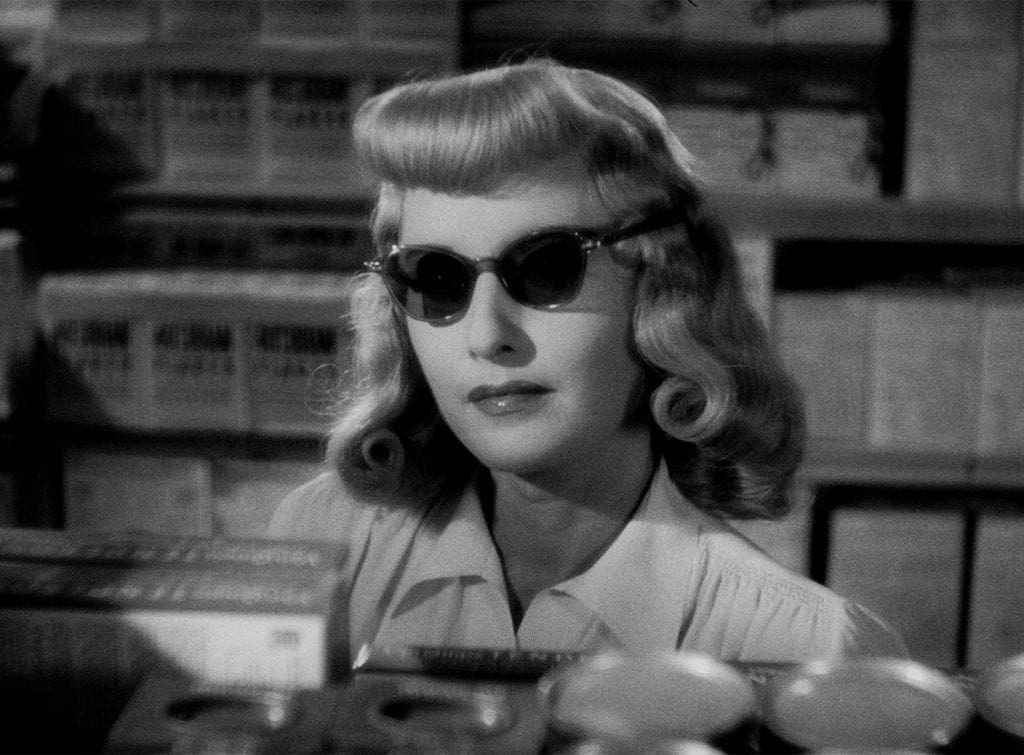
Barbara Stanwyck in Double Indemnity
In this appreciation of the femme fatale, Michaela Owens looks at two of cinema’s coolest and most indelible, Phyllis Dietrichson and Matty Walker.
In a blackened office, Fred MacMurray bitterly recounts his story of lust and crime into a Dictaphone as he slowly bleeds out, a consequence any man deserves after squaring off against the indomitable Barbara Stanwyck. Faced with the repercussions of his sins, MacMurray sums up the situation succinctly: “I killed him for money and a woman — and I didn’t get the money and I didn’t get the woman. Pretty, isn’t it?” When the French critics labeled movies like this one film noir, they had become aware of something distinct happening in American cinema, where urban, rain-soaked streets were trod on by gritty cynics operating in the shadows, the disenfranchised and disillusioned struggled to beat society’s crooked systems, and duplicitous women slinked up to morally ambiguous men to ask for a smoke.
Out of all of film noir’s characteristics, it is that last one that intrigues me the most. During World War II, women’s opportunities to move into the workforce and inhabit non-traditional roles fed into male fear, resentment, and insecurity regarding their own place in the world once they returned home. This idea seeped into the foundation of the film noir, eventually creating one of cinema’s most endurable images: the femme fatale. This isn’t to say that bad girls weren’t already slithering around on the silver screen before this — think of the seductive “Woman from the City” in Sunrise (1927), Jean Harlow’s unrepentant vamp in Red-Headed Woman (1932), or Myrna Loy’s vengeful murderess in Thirteen Women (1932) — but noir immortalized her into something more dangerous and mythological, a woman whose ambition to break free of her patriarchal oppression manifests in a non-conformity that terrifies and astonishes those around her.
Decades after the heyday of noir, as second-wave feminism challenged gender norms and women’s role in society and new president Ronald Reagan backed policies that restricted money for international family planning and would’ve banned abortion and other birth control in addition to opposing the Equal Rights Amendment, which explicitly prohibited sex discrimination, it isn’t difficult to see how the femme fatale reemerged in the 1980s and genres like the neo-noir and erotic thriller began to thrive. Anxiety about women and their capabilities is part of what makes these films so fascinating, and none are more iconic than 1944’s Double Indemnity and its unofficial remake, 1981’s Body Heat.
Adapted from James M. Cain’s novel by Billy Wilder and Raymond Chandler, Double Indemnity follows cocky insurance agent Walter Neff (Fred MacMurray) as he falls for the married Phyllis Dietrichson (Barbara Stanwyck), who slyly convinces him to plot her husband’s death and make it appear to be an accident, thus invoking the double indemnity clause of his insurance. Once the murder is complete, Phyllis and Walter’s relationship becomes strained and soon they’re turning on each other until neither of them are left standing by the close of the last reel.

Hurt and Turner collide in Body Heat
Starring William Hurt as sketchy lawyer (and clueless hottie) Ned Racine and Kathleen Turner as lonely housewife Matty Walker in her scorching film debut, Body Heat is essentially the same story with an important twist that the Production Code of classic Hollywood would’ve never sanctioned: minutes before the couple is arrested, Matty fakes her death with an explosion, leaving Ned to rot in prison while she starts over in a tropical paradise.
Exemplifying WWII- and Reagan-era womanhood, Double Indemnity and Body Heat simmer with an anger towards and mistrust of women that reinforces why characters like Phyllis and Matty break bad. Their intelligence is dismissed (as Matty sarcastically remarks, “I’m too dumb—a woman, you know”); their bodies are sexualized (it’s almost too comical how Walter fetishizes Phyllis’s anklet and Ned tells Matty her perfectly normal skirt and blouse are too suggestive); and their mobility is dependent on spouses they hate. From the shameless up-and-down glances of their lovers to the surveillance of the insurance company and police investigating them, Phyllis and Matty (and even Lola, Phyllis’s stepdaughter) are continually under scrutiny — as women, they have to be watched, their actions tracked and questioned. The irony, of course, is that this spotlight on them allows their male partners in crime to cover their tracks and slip by unnoticed longer than they should.
The crux of the women’s deception is their ability to put these men on a pedestal, to let them think that they are these women’s saviors, delivering them from a boring life of domesticity that consists of cloying stepdaughters and nieces, lonely days spent in big empty houses, and bad sex with older husbands. One bit of blocking from director Lawrence Kasdan illustrates this brilliantly when Matty gifts Ned a fedora. Sitting in his car, she rolls up the passenger window to let him see his reflection and, in the process, allows his image to supersede her own so he can admire himself. Tapping into Walter and Ned’s long-seeded desire to cheat the system, Phyllis and Matty let the lovesick women they are projecting themselves as be controlled by obeying the men’s instructions on how to execute the murder and when, where, and how they can communicate after the deed is done. The women’s phone calls especially are a sign of deference as they ask for permission to do things or seek assurance that they’ve performed correctly, lulling the men into a state of false security within their relationship. When Phyllis and Matty step outside of this by making an unplanned call, showing up at the office unexpectedly, or invalidating their husband’s will after being told not to, they’ll apologize and pant and reaffirm their love, but they know what they are doing: destabilizing these schmucks and warning them of who is really running the show.
Throughout these films, these femmes remain enigmatic, as difficult to grasp as the smoke wafting from their cigarettes. Walter and Ned are humanized by their friendships with other men, but Phyllis and Matty are more isolated, thus amplifying their greed and sexuality until those become their defining characteristics. In Cain’s novel, Phyllis’s sociopathy is rather heavy-handed as we discover that before Walter came along, she had killed her husband’s previous wife in addition to three children while working as a nurse, two of which were just to divert attention away from the one whose demise she was able to gain from financially. Dreamily telling Walter that Death is her real bridegroom, the novel then closes with the couple committing suicide together by leaping into shark-infested waters, a metal ending for a metal femme fatale.

Phyllis stares down Walter at the supermarket
With a steel backbone and cheap blonde locks, Stanwyck’s Phyllis is still plenty terrifying, albeit in a more grounded way. The implied murder of the first Mrs. Dietrichson stays in Wilder and Chandler’s script, but not the literary Phyllis’s unsettling intoxication with the Grim Reaper — instead, what chills us here is Stanwyck’s remarkable, calculated performance. Whereas Matty professes her love for Ned right up until the fiery end, Phyllis drops all pretenses once Walter starts to become skittish about the final phase of their plan. Standing across from each other in a supermarket, he frets about how close Keyes is to solving the case while she stays eerily calm, a reversal of their usual dynamic. Reminding him that the murder was his scheme, she removes her sunglasses to reveal deadened eyes and, with a face that barely moves, tosses back at him a phrase he had said to her at the beginning of this nightmare: “We went into this together, we’re coming out at the end together. ‘Straight down the line.’ Remember?”
With Double Indemnity told exclusively from the viewpoint of Walter, you have to wonder how exaggerated Phyllis’s ruthlessness is. Did she really show “no nerves, not a tear, not even a blink of the eyes” as they disposed of her husband’s body? When the life was being strangled out of him in the car, did she actually sit next to him with that much composure, her eyes shining and a slight smile coming to her lips? As Walter’s confessional, the script and MacMurray’s performance offer redeeming moments for the character, such as his uneasiness with innocent Lola becoming part of the scheme and his saving her boyfriend, Nino Zachette, from being accused of killing Phyllis. But it has to be reiterated: although a financial windfall and a beautiful woman were compelling incentives, the fact remains that Walter murdered a man just to prove how smart he is. At the end of the film, Phyllis accepts their guilt while Walter tries to absolve himself of it:
Phyllis: “We’re both rotten.”
Walter: “Only you’re a little more rotten. You got me to take care of your husband for you. And then you get Zachette to take care of Lola, maybe take care of me, too. Then somebody else would come along to take care of Zachette for you. That’s the way you operate, isn’t it, baby?”
Phyllis: “Suppose it is. Is what you’ve got cooked up for tonight any better?”
Recognizing death as the ultimate immobilization, they dance around the inevitable until she is the first to pull the trigger. He dares her to take another shot, but for the only time in the film, Phyllis falters. Surprising even herself, she admits, “I used you just as you said. That’s all you ever meant to me…until a minute ago, when I couldn’t fire that second shot. I never thought that could happen to me.” Shooting her as she embraces him, he believes he is demonstrating that he is the stronger of the two, pointedly pumping her with the second bullet that she could not fire. But Phyllis’s damage is already done: it may have taken two shots to vanquish Phyllis Dietrichson, but it turns out only one is needed to do the same to Walter Neff — who might’ve lived had he tended to his wound rather than bleed out just so he could hear the sound of his voice for two hours as he explained how clever he had been and how a woman made it all unravel. (We can only hope that when it came time to fill out the death certificate, the coroner wrote “his own ego” as the cause.)

Matty’s inscrutable final look
While Matty hints at a dark past that included an addiction to speed, her motivation is more bluntly spelled out in the yearbook that Ned obtains, where her listed ambition is “to be rich and live in an exotic land.” Is that all there is to her, though? In the film’s final minutes, as ocean waves tumble onto the shore and tropical flowers tremble from the breeze, Matty’s expression isn’t one of triumph. Looking into the distance, she seems lost in thought, maybe even regretful, her hair tousled by the wind and her face softened in a way that makes her look years younger while she lets out a noiseless sigh. When her male companion makes a comment about the hot weather — a callback to her first encounter with Ned — she becomes annoyed, her voice hard as she gives one-word replies, exhales deeply, and puts on her sunglasses (a Phyllis-approved move, surely). As the camera closes in on her profile, her expression is unreadable. Did she feel something for Ned after all? Maybe, but it doesn’t matter. As Walter’s bullets cruelly reminded Phyllis, hesitation and sentimentality are death in their world, and Matty is a goddamn survivor.
Whereas Walter wants to plea temporary insanity by means of the world’s sexiest ankle bracelet, Ned respects Matty’s unscrupulousness. When her husband tells Ned that in order to succeed you have to do “whatever is necessary” to get ahead, it echoes an idea that was exalted by many young, white, cisgender men in the ‘80s as yuppie culture began to take root. Ned replies that he is that kind of person, but once he is caught, he realizes that Matty’s relentlessness made her that person, too, even more than him. Her entire plan was “so perfect, so clean,” he says without venom. Unlike Walter, Ned manages to keep his life — but not his freedom. Confined to a cage as Matty sunbathes on a beach with her new boy toy, he gets to live with the knowledge that he was outsmarted at every turn and that no one may ever believe him that the dame who set this all in motion is still breathing.
Ned’s sudden exclamation of “She’s alive!” is not only a shocking reveal to a familiar story, it is a sigh of relief for any audience that is tired of seeing willful, rebellious women punished in films like this. Perhaps more importantly, it is also a reminder that you shouldn’t underestimate the power of the femme fatale, culturally, emotionally, or even historically. No matter what her cinematic fate is, her black heart will still beat and her potency will linger, like the scent of honeysuckle in the California air or the intense heat of a Florida summer.
Double Indemnity and Body Heat will be screened on February 23 and February 24 respectively as part of the Re:Made series. Additionally, the screening of Body Heat will be followed by a conversation on the role of intimacy coordination in film between Jessica Steinrock (CEO, Intimacy Directors and Coordinators) and Jenny McKnight (IU Theatre).